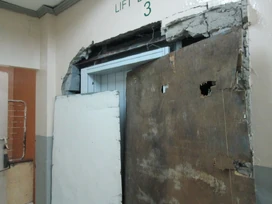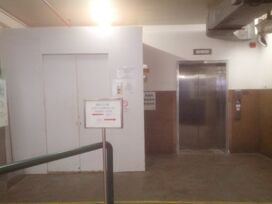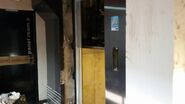IDLift3000 (talk | contribs) |
m (→See also) |
||
| Line 30: | Line 30: | ||
==See also== |
==See also== |
||
| − | *[[Lift Upgrading Programme]] (Singapore) |
+ | *[[Lift Upgrading Programme]] (Singapore, discontinued project) |
| − | *[[Lift Modernisation Programme]] (Hong Kong) |
+ | *[[Lift Modernisation Programme]] (Hong Kong, ongoing project) |
==External links== |
==External links== |
||
Revision as of 17:45, 1 September 2014

An elevator is being modernized into Schindler 3300 AP MRL in 2013. The former elevator was a 1991 Dong Yang hydraulic elevator.

An elevator is being modernized into Schindler 5500 elevator in 2013. The former elevator was a 1980s Falconi traction elevator. The right one already modernized.
Elevator modernization (or lift modernisation) is the process of upgrading the critical parts of the elevator in order for it to be able to handle new technology, have better performance, improve safety, and even give the aesthetics an up-to-date appeal[1][2].
Typically, a modernization will affect the controller equipment (the part of the elevator that controls the movement of the elevator through the floors), the hoist machines and motors (the part of the elevator that does the heavy lifting), electrical wiring and buttons of the cab (controlling the lights, destination floors, etc.,) even the tracks of the doors are sometimes modified and changed, all to keep the elevator up-to-date, and to the aesthetics conscious, paneling, electronics, and additional style changes can also be done in the interior of the cabs.
Most elevators are built to provide about 30 to 40 years of service (although some elevators as old as 50 years or more are still in service), as long as service intervals specified and periodic maintenance/inspections by the manufacturer are followed. As the elevator ages and equipment become increasingly difficult to find or replace, along with code changes and deteriorating ride performance, a complete overhaul of the elevator may be suggested to the building owners[3].
Sometimes, elevator (lift) replacement work also applied in this term.
The proccess
- Please refer to Elevator major alterations.
For starters, an elevator modernization plan will have to be created. This is done usually with the help of an elevator service company which can also do modernization.
This process will determine which parts of the elevator will have to be modernized, the scope of the procedure, and most importantly, making sure that code compliance is met. Once this is done, preventive maintenance will have to be done until the elevator is removed from service.
During this time, the elevator will be out of service, so building owners will have to compensate for this. This includes proper diversion of building’s traffic, creating contingency plans, and so on. This is needed because depending on the amount of modernization done, the number of elevators, and the size of the building, the whole process may take anywhere from a few months, to a whole year.
Benefits of elevator modernization
Modernization can greatly improve operational reliability by replacing mechanical relays and contacts with solid-state electronics. Ride quality can be improved by replacing motor-generator-based drive designs with Variable-Voltage, Variable Frequency (VVVF) drives, providing near-seamless acceleration and deceleration. Passenger safety is also improved by updating systems and equipment (such as double brake system, unintended car movement protection device on the brake system[4][5]. etc.) to conform to current codes.
Problems of elevator modernization
Many vintage elevator enthusiasts dislike elevator modernization, because it reduces the aesthetic appeal of the elevator with a generic, modern design, and also may not blend in with the architecture of historic buildings. Also, some people criticize that modernized elevators aren't as well made or have as long a lifespan, because of the sensitive electronic controllers, cheaper made mechanical parts, and fast work method. As a result, some people say that elevators should not be modernized, unless it's absolutely needed, and if so, should be done in a high quality, efficient manner.[6]
Gallery
Notes and references
- ↑ Electrical and Mechanical Services Department, Hong Kong - Circular No. 19/2011 Guidelines for Modernising Existing Lifts
- ↑ Modernisation of aged lifts Enjoy a safer and more reliable ride (Chinese version) (Electrical and Mechanical Services Department, Hong Kong)
- ↑ Guidelines for Modernising Existing Lifts (Chinese version) (Electrical and Mechanical Services Department, Hong Kong)
- ↑ What is an Elevator Rope Gripper (by ElevatorAdjuster)
- ↑ Lift Rope Brake (by hkelev.com)
- ↑ Generic lift companies (Beno.org.uk)
See also
- Lift Upgrading Programme (Singapore, discontinued project)
- Lift Modernisation Programme (Hong Kong, ongoing project)
External links
Government official guidelines
- Guidelines for Modernising Existing Lifts (Chinese version) (Electrical and Mechanical Services Department, Hong Kong)
- Lift Modernization Safe Use of Lifts & Escalators (Electrical and Mechanical Services Department, Hong Kong)
Fan-made guidelines

|
"This elevator only serves two floors." This article is a stub. You can help Elevatorpedia by expanding it. |
